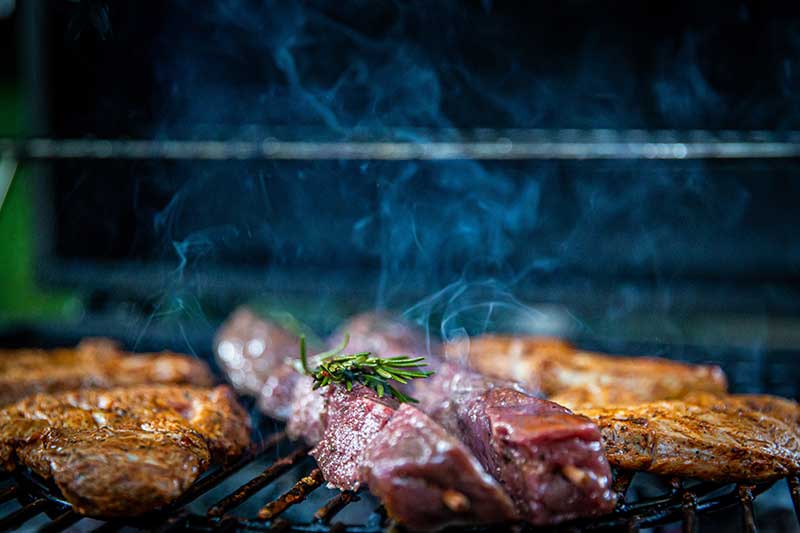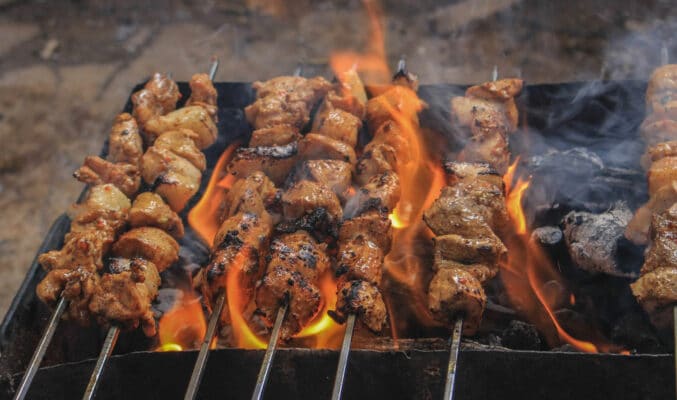The customer service team is always listening, taking notes, and quantifying complaints to ensure our products are continually improved. Due to selling directly to you, the customer, via Amazon, we can use product reviews to help us improve our existing products or help further development of new products.
How to Make Good Grill Marks
Table of Contents
Even though grill marks are mostly a cosmetic enhancement, you should know how to make them to get the raves about your meat that proper cooking can generate. Knowing how to make grill marks on steak is a critical skill in today’s competitive cooking culture, but it’s more about presentation than flavor.
Why Are Grill Marks Important
Grill marks are the lines, usually arranged in a diamond pattern, that define grilled meats and vegetables. Marketers go wild over beautifully clear grill marks on food, and the marks really can improve the flavor of bland meat by intensifying caramelization in the meat or veggies.
Caramelized food develops more complex flavors, but in truth, browning meat all over to a golden brown consistency adds even more flavor than caramelizing a few lines on the meat.
Tips to Ensure Perfect Grill Marks
Regardless of whether you want to create perfect grill marks or get a dark, golden crust on your meat, a food thermometer is essential. Grills must be at a high temperature to grill lines on the meat and to sear meat to retain the juices that make it tender.
One of the best options for food thermometers is the ThermoPro Food Thermometer. The manufacturer carries a full line of thermometers that includes remote digital cooking thermometers, which are perfect for taking the temperature of meat on a hot grill, and waterproof food thermometers for smoker grilling. You can produce perfect grill marks on your food by following these steps:
- Monitor the temperature of your grill with a food thermometer.
- Oil the raised lines on the grill to prevent sticking.
- Cook at a high temperature of around 500 degrees.
- Rotate the food a little over halfway through the cooking time on the first side to produce a cross-hatch effect
- Press the meat to ensure the grill marks are highly visible.
- Turn the food over and monitor the temperature with a meat thermometer to ensure reaching the proper temperature for the desired degree of doneness.
- Place the food on the plate or platter in a way that highlights the grill marks.

The Science of Grill Marks
Scientifically, beautiful grill marks aren’t that important because the surface area of the caramelization is small. The goal of cooking meat and other foods is to get the dark surface color from searing, roasting, etc.
The dark color is caused by caramelization that changes the food’s chemistry. This is called the Maillard reaction, and it’s a process that all great chefs know well – even if they don’t know what the reaction is called. That’s why great chefs always prepare pan sauces using the pans where the meat was cooked to incorporate the browned bits.
The Maillard reaction changes amino acids, sugars and protein into tasty caramel, and the more intense the color, the stronger the flavor. In New Orleans, they cook their roux until it’s blackened to take advantage of the Maillard reaction in cooking roux as thickeners for gumbos, soups, stews and etouffees.

The tasty compounds of the Maillard reaction give complex flavors to food when searing the surfaces well. Unfortunately, grill marks only sear a small part of the meat or vegetables. If you’re really looking for the best flavor, use your thermometer to preheat your pan to a high temperature, sear your meat on both sides to a dark brown color and finish cooking time in a calibrated over the proper internal temperature using a meat thermometer. You can also roast vegetables to caramelize them.
The best chefs know that there are as many myths in cooking as there are truths. Grill marks are superficial, but an overall surface sear is not. You can create layers of flavor by defying another myth – that you should only flip meat once. That’s only true if you’re trying to get perfect grill marks.
The flip-once myth might help cooks to avoid mashing the meat, but careful turning meat allows you to develop caramelization gradually to get the best flavor and preferred degree of doneness. Meat cooks faster this way, don’t dry out and retains moisture. Each time you flip the meat, it continues cooking on the top while the bottom introduces new heat. The meat cooks faster and more accurately, and there’s a chance of overcooking it.
Diamond Grill Marks Indicate Perfect Grilling Skills
Most professional cooks want to know how to make diamond grill marks, and amateur chefs follow suit to prepare foods with over-the-top presentation skills. If you’ve ever watched Emeril Lagasse, you’ll notice that he often keeps adding garnishes that cover and hide the food. Cooks need to know when to stop garnishing to let the food shine through and capture a diner’s attention.
Diamond grill marks do this perfectly, and proper placement of grill marks indicates that the cook has great control and strong grilling skills.
As always, grilling meat requires accurate temperatures, so it’s important to have a reliable meat thermometer handy – such as the ThermoPro Food Thermometer. Preheat your grill to a very high temperature – 500 degrees to 550 degrees. Meanwhile, seasons steaks on both sides with salt, pepper and other desired seasonings.
Place the meat on the grill with the ends located at the 10 and 4 clock positions. When the meat has seared sufficiently, rotate the steaks clockwise to the 2 and 8 clock positions. After the second set of grill marks are seared, the steak can be turned over and cooked to the desired degree of doneness. The grill marks will form a perfect diamond pattern and generate praise far in excess of what is deserved for the simple process.
Grilling Myths and Absolute Truths
There are many myths about cooking and grilling that are worth exploring as long as you remember not to upset the apple cart of people’s belief in grill marks. Everyone seems to want them, so you need to learn how to make diamond grill marks and even make grill marks without a grill.
Some of the most deeply held cooking beliefs are myths. Grill marks can add some flavor, but a great cook can add more flavor by ensuring that the bottom of the meat is cooked to a perfect Maillard sear.
A Maillard sear requires an overall sear, and a heavy cast-iron skillet is the perfect tool. Rub the skillet lightly with oil, preheat the skillet to a high temperature and sear the meat until the surface caramelizes in a Maillard reaction.
If you want smoky flavor, don’t use a pan. You can use sheep wire c=grill grates over any open flame or barbecue pit to sear grill marks into the meat. You’ll have to be more careful with the flame, but you get good grill marks and intense flavor – especially if you brown the bottom on a flat-top, frying pan or in the oven. The more mahogany the color, the better the flavor will be.
How to Make Grill Marks Without a Grill
Cheap wire grates can be used in pans or flat-top cookers to sear lines into the meat even if you don’t have a grill. You can also place the meat directly on one of the oven’s wire grid shelves with something to catch the drippings on the lower shelf. Oiled and preheated, the shelf grid can produce great grill marks.
You can also cook meat in a cast iron pan with ridges that allows the fat to drip into the ridges. If you reheat the pan hot enough, you’ll get great sear marks. You can also cook meats directly on the grates of a hibachi to get those highly prized marks.

Conclusion
The primary tool of successful chefs is a reliable thermometer to gauge the heat of the cooking source and test how meat is progressing to the rare, medium or well-done stage. The hoopla generated by Madison Avenue and marketing ”experts” has convinced many people to buy-in to the into the value of grill marks so completely that no serious cook can afford to ignore the presentation value of clear grill marks.
However, you can often cook the bottom of the steak until it sears enough to produce the complex flavors that result from the Maillard reaction. Unfortunately, this is difficult to do with meat that’s only cooked to the rare stage, but there are techniques that creative chefs can use to get full-flavor and grill marks on rare meat. These include using squeeze bottles to sauce rare steaks to highlight paler grill marks while getting a good sear on the other side.
It’s great to know how to make great grill marks, but it’s even better to know how to use thermometers to cook meat precisely while caramelizing the meat well to produce the most flavorful food possible.









